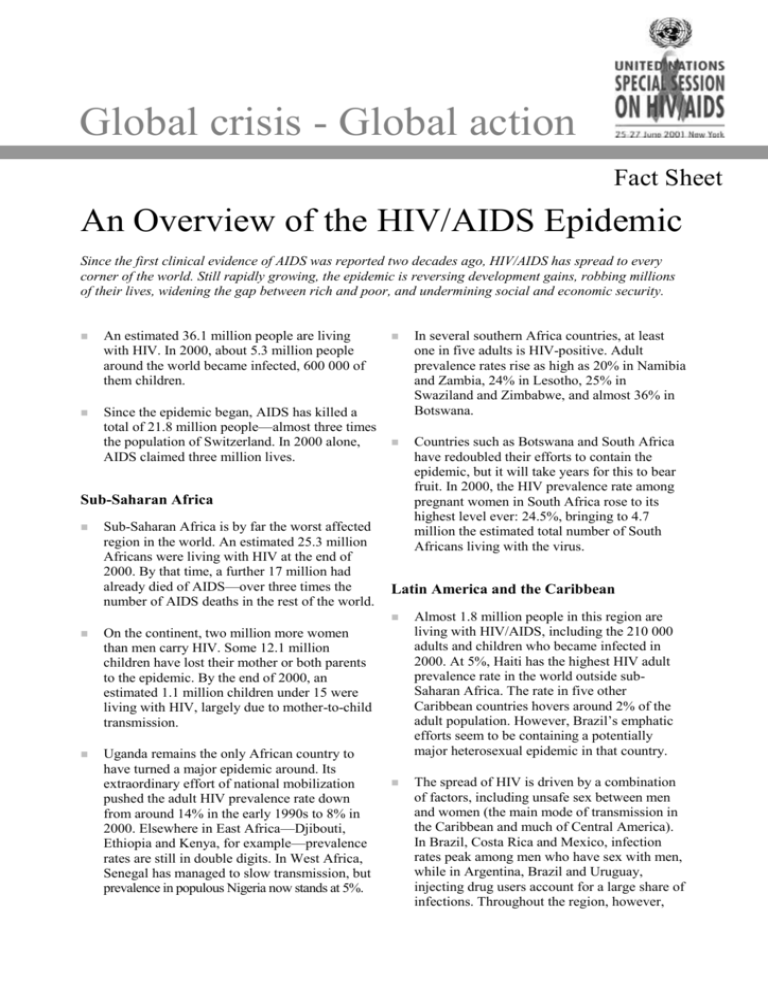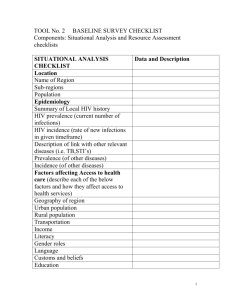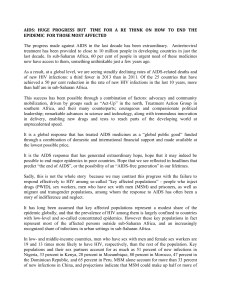doc - the United Nations
advertisement

Global crisis - Global action Fact Sheet An Overview of the HIV/AIDS Epidemic Since the first clinical evidence of AIDS was reported two decades ago, HIV/AIDS has spread to every corner of the world. Still rapidly growing, the epidemic is reversing development gains, robbing millions of their lives, widening the gap between rich and poor, and undermining social and economic security. An estimated 36.1 million people are living with HIV. In 2000, about 5.3 million people around the world became infected, 600 000 of them children. Since the epidemic began, AIDS has killed a total of 21.8 million people—almost three times the population of Switzerland. In 2000 alone, AIDS claimed three million lives. In several southern Africa countries, at least one in five adults is HIV-positive. Adult prevalence rates rise as high as 20% in Namibia and Zambia, 24% in Lesotho, 25% in Swaziland and Zimbabwe, and almost 36% in Botswana. Countries such as Botswana and South Africa have redoubled their efforts to contain the epidemic, but it will take years for this to bear fruit. In 2000, the HIV prevalence rate among pregnant women in South Africa rose to its highest level ever: 24.5%, bringing to 4.7 million the estimated total number of South Africans living with the virus. Sub-Saharan Africa Sub-Saharan Africa is by far the worst affected region in the world. An estimated 25.3 million Africans were living with HIV at the end of 2000. By that time, a further 17 million had already died of AIDS—over three times the number of AIDS deaths in the rest of the world. On the continent, two million more women than men carry HIV. Some 12.1 million children have lost their mother or both parents to the epidemic. By the end of 2000, an estimated 1.1 million children under 15 were living with HIV, largely due to mother-to-child transmission. Uganda remains the only African country to have turned a major epidemic around. Its extraordinary effort of national mobilization pushed the adult HIV prevalence rate down from around 14% in the early 1990s to 8% in 2000. Elsewhere in East Africa—Djibouti, Ethiopia and Kenya, for example—prevalence rates are still in double digits. In West Africa, Senegal has managed to slow transmission, but prevalence in populous Nigeria now stands at 5%. Latin America and the Caribbean Almost 1.8 million people in this region are living with HIV/AIDS, including the 210 000 adults and children who became infected in 2000. At 5%, Haiti has the highest HIV adult prevalence rate in the world outside subSaharan Africa. The rate in five other Caribbean countries hovers around 2% of the adult population. However, Brazil’s emphatic efforts seem to be containing a potentially major heterosexual epidemic in that country. The spread of HIV is driven by a combination of factors, including unsafe sex between men and women (the main mode of transmission in the Caribbean and much of Central America). In Brazil, Costa Rica and Mexico, infection rates peak among men who have sex with men, while in Argentina, Brazil and Uruguay, injecting drug users account for a large share of infections. Throughout the region, however, heterosexual transmission is becoming an increasingly important factor in the epidemic. 250 000 people were living with HIV/AIDS by 2000. In 1986, only a few cities in the Russian Federation reported HIV cases; today, almost all its regions harbour the virus. Although the epidemic is still concentrated among injecting drug users and their sexual partners, growing prostitution and high levels of sexually transmitted infections could, in a climate of jolting social change, cause it to spread rapidly into the general population. Asia and the Middle East Some 6.4 million people in Asia carry the virus and determined steps are needed to prevent a massive increase in their numbers. China seems especially prone to an epidemic because of the recent steep rise in sexually transmitted infections and the large-scale transmigration of people (spurred by economic growth). Industrialized countries An estimated 780 000 people became infected in South and South-East Asia in 2000, with HIV prevalence exceeding 1% in Cambodia, Myanmar and Thailand. Because of India’s vast population, its low prevalence rate (0.7%) nonetheless translates into 3.7 million people living with HIV/AIDS—more than in any other country besides South Africa. The notion that the epidemic is a thing of the past in high-income industrialized countries is unfounded. Almost 1.5 million people live with HIV in those regions, many of them productively, thanks to pervasive antiretroviral therapy. But that achievement is overshadowed by the fact that prevention efforts are stalling in most industrialized countries. In North Africa and the Middle East, infections are rising off a low base. Across the region, there were an estimated 80 000 new infections in 2000, bringing to some 400 000 the number of people living with HIV/AIDS. Localized studies in Algeria, for instance, reveal prevalence rates of about 1% among pregnant women. Infection rates in some American cities are again rising among men who have sex with men; one urban United States study has revealed an HIV prevalence of 7.2% in this group. Also reported are sharp increases in sexually transmitted infections among men who have sex with men in Amsterdam—an indication that unsafe sex threatens to become the norm again. There are signs that unsafe sex between men might be a growing factor in Eastern Europe's epidemic. In some countries, the epidemic is shifting towards more vulnerable people—especially ethnic minorities who, because they face discrimination and social exclusion, appear to face disproportionate risks of infection. They are also more likely to be missed by prevention campaigns and deprived of access to treatment. HIV prevalence rates among injecting drug users give special cause for alarm: 18% in Chicago and as high as 30% in parts of New York. By contrast, needle and syringe exchange schemes in Australia are slowing the increase in prevalence among injecting drug users. Central and Eastern Europe Infection rates are climbing alarmingly in Eastern Europe and Central Asia, where overlapping epidemics of HIV, injecting drug use and sexually transmitted infections are swelling the ranks of people living with HIV/AIDS. Most of the quarter million people who became infected in 2000 were men. In some parts of the region, more HIV infections occurred in 2000 than in all previous years combined. New epidemics have emerged in Estonia and Uzbekistan, while, in Ukraine, more than






